Unfortunately, I know the world that I live in. As a woman, I have to live with the fact that 20% of women will be raped in their lifetime. A third of us women will be sexually assaulted. And then there’s assault in the form of mugging and other violence. This is why I, as a woman, choose to carry a self-defense weapon.
There are a lot of self-defense weapons out there. This isn’t going to be one of those posts which lists a bunch of weapons, though. Most weapons advertised for self-defense are utterly ineffective in real-life situations.
Here’s why and which weapons really work.
Top Recommendations
Why All Women Should Carry a Self-Defense Weapon
As I talk about in my post about self-defense for women, there’s a lot of controversy about whether you should fight back against an attacker. The argument is that fighting back increases the risk of injury.
This is a dangerous misconception: Studies show that women who fought back against attackers were able to stop the assault in half of the cases. Fighting back did not increase the risk of injury. On top of that, the studies found that using a self-defense weapon is most effective in stopping harm.
This doesn’t mean that a weapon will save you every time. However, simply having a weapon can increase your confidence – and that confidence makes you less likely to be a target in the first place. (1, 2)
 Disaster Preparedness For Women: 52 Steps To Get Ready For Any Emergency
Disaster Preparedness For Women: 52 Steps To Get Ready For Any Emergency
The Most Sensible Disaster Prepping Book You’ll Ever Read?
In Disaster Preparedness for Women, Diane Vuković takes a refreshingly level-headed approach to prepping specifically geared towards women. Available in paperback or on Kindle
Attack Distance and Self-Defense Weapons
When it comes to weapons, you’ll see a lot of arguments along the lines of “Is a knife or gun better for self-defense?” Anyone who says that one is better than the other is overlooking the importance of distance. Many self-defense weapons only work at specific distances.
Tueller and 21 Foot Rule
In 1983, a police Sergeant named Denis Tueller wondered how close would be “too close” to draw your weapon in time if an attacker with a knife was rushing toward you. He did a series of tests, and the results were published in SWAT Magazine.
Tueller found that it only takes 1.5 seconds for a person to cover 21 feet. Even elderly or unfit people could cover this much ground in 1.5 seconds. Physical fitness only starts to matter at longer distances.
That means anyone within 21 feet of an armed attacker is in the danger zone.
Many firearm owners react to this information by running “Tueller drills,” where they practice drawing their weapons and shooting at a target at 21 feet. While this is a good drill to practice, it overlooks an important reality:
Most Attacks Occur at Very Close Range
Almost every attack will happen at a close range, usually within 4 feet. Attackers hide in blind spots and jump out to surprise their victims. They wait for them in the backseats of their cars. Or, for many women, the attacker breaks into their home at night and climbs on top of them while they sleep…
IMPORTANT
You don’t get to choose the distance. The distance chooses you.
Once the attacker is at close distance, you will NOT have time to draw a weapon.
The real lesson from the 21-foot rule?
Many people running Tueller drills overlook the real lesson of the original article: The importance of awareness.
If you can detect a threat before the attacker gets close – like being aware of the creepy guy following you home – you will be able to draw your weapon and initiate self-defense before he gets too close.
Draw your weapon the moment you sense a threat – NOT once you are under attack. And, because you can’t always detect a threat before it is upon you, be ready to use close-contact self-defense methods.
Best Self-Defense Weapons for Women
Below are the self-defense weapons which actually work. I’ve listed whether they work for close-range or far-distance attacks. You might be surprised which weapons did and didn’t make it to this list.
1: Your Voice
Effective for: All distances
I know this isn’t what you thought when I said “weapon” for self-defense. But screaming is proven to prevent assaults. (6)
When you scream, you are:
- Startling the attacker
- Telling the attacker that you won’t be a passive victim
- Drawing attention to yourself
- Increasing adrenaline and readying your body for a fight
Yet, many women don’t scream when they are assaulted.
Why?
A lot of it has to do with how we women are trained by society to “be nice” all the time. There’s also that little voice in our heads saying, “This isn’t really happening…”
This is partly why so many women freeze up and stay silent while being assaulted. A good self-defense course will help you to overcome all those years of conditioning to “be polite and quiet” so you can use your voice as a self-defense weapon.
Tip: Don’t wait until you are being attacked to scream. If you think you are under threat, scream your head off. It is better to feel like an idiot for screaming unnecessarily then get killed because you questioned your instincts!
2: Pepper Spray
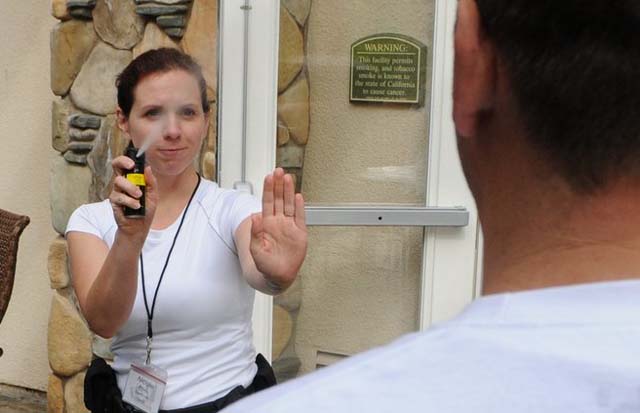
Effective for: Within 10 feet
Pepper spray is a highly effective self-defense weapon. It is considered the best self-defense weapon for rape prevention by many experts.
Why? It has to do with how easy it is to use pepper spray. Further, pepper spray is non-lethal. It might seem like lethal self-defense weapons would be better. However, our self-doubt can hinder us from making use of them. If a creepy guy walks too close for comfort, you are more likely to pepper spray him than risk killing an innocent bystander.
I can testify to this personally. After a guy driving backward almost hit my child’s stroller as we went through an intersection, I used my palm to hit his car (which was a mistake; you should never engage!).
He got out of the car and started coming toward me in a very threatening manner. I didn’t hesitate to draw my pepper spray and blast him in the eyes, giving me time to get away. Had I pulled a firearm, I’d likely be facing criminal prosecution.
Most pepper spray has a range of 4 to 15 feet. There are pepper spray guns with longer ranges (around 21 feet). Because these are bulky, the key chain pepper spray is probably the better option. It is faster to deploy, and most attacks occur at close range anyway.
Also read our guide to the pros and cons of pepper spray vs gel.
Read our post on the best pepper spray to learn more about the options.
3: Your Fingers
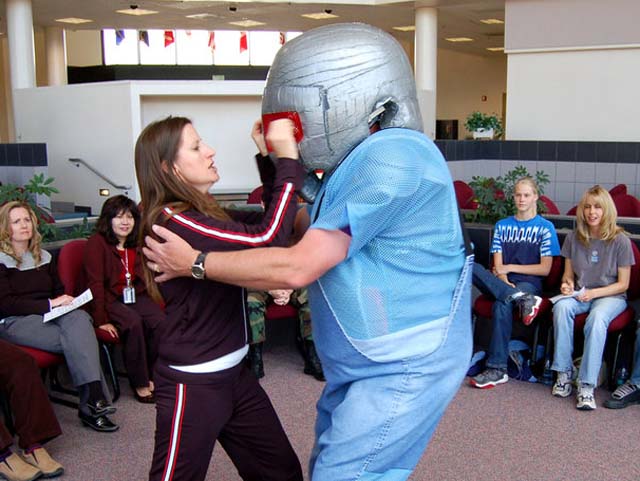
Effective for: Close-range
Again, this is not what you consider a self-defense weapon. But remember that most attacks occur at close range. Using your fingers to jab an assailant in the eyes is one of the best self-defense moves – especially for small women assaulted by a larger attacker.
A jab to the eyes is effective – but it’s hard to overcome the sick feeling that comes with doing this (I find it gross to even think about it). You won’t give a flying F about gauging an attacker’s eyes if he’s trying to kill you. However, overcoming everything we’ve been taught about not hurting others can be challenging.
That’s why training is so necessary. You must practice eye jabs on a fake attacker so that you don’t hesitate in a real-life situation.
4: Personal Alarms
Effectiveness: All ranges
Because of how prevalent car alarms are (and how often they are ignored), there’s a lot of debate about whether personal alarms work. However, anything that draws attention to you will reduce the likelihood of a completed assault.
There are now many more options for self-defense alarms. These include voice-activated alarms on your phone. Phone alarms aren’t as loud, but they will be able to notify people around you about the attack.
Read our guide to the best personal safety alarms
Self-Defense Weapons that Are Sometimes Effective
These self-defense weapons for women can be very effective in preventing attacks and injury. But there’s a catch: For them to work, you have to have a lot of training or be at a specific distance.
If you plan on carrying one of these weapons for self-defense, you should be prepared to take a class that fully trains you to use them in real-life situations.
5: Firearm
While firearms usually make the #1 spot for best self-defense weapon, they have a lot of flaws in real-life assault situations. Most assaults (especially sexual assaults on women) occur at close range. You simply don’t have time to draw a concealed weapon.
Because of all the controversy around guns (which we will NOT get into here!), it’s hard to find actual evidence about how effective carrying a gun is for preventing assaults on women. A lot of the evidence does point to the contrary, though: Carrying guns doesn’t reduce the likelihood of a woman getting assaulted or raped. This is likely to do with the fact that guns can’t be deployed quickly during assaults.
In some cases, having a weapon can INCREASE a woman’s risk. Why? Because carrying a gun can give a woman a false sense of security. Researchers posited that,
The fact that you have a gun may mean that you do things you shouldn’t be doing: you take chances you shouldn’t otherwise take; you go to places where it’s really not safe, but you feel safe… This added risk may overpower any protective effects.
The bottom line? Carrying a firearm for self-defense is fine, but don’t rely on it alone to keep you safe!
6: Knives and Hidden Knives
I love knives and always carry at least a small one as my EDC. It is handy for many situations and could be a lifesaver in more serious scenarios.
But, as far as self-defense goes, knives generally aren’t the best option (for men and women alike).
Here are the problems with knives:
- There’s a high likelihood of an unskilled person with a knife being disarmed and the blade being used against them.
- Knives are only practical for close-contact assaults.
- It takes a lot of skill to fight back effectively with a knife.
However, knives can still be a good self-defense tools in extreme situations. If you get kidnapped (which the likelihood of is very rare), you could use a hidden knife to defend yourself or free yourself from restraints.
When choosing a self-defense knife, use the 3/3 rule: the blade should be 3mm thick and 3 inches long. This way, the blade will be strong enough to be effective but light enough to use.
Read more about the best knives for self defense.
7: Tactical Pens and Keychain Weapons
Tactical pens can stab an assailant in the eyes or other vital targets. However, like knives, this requires a lot of practice.
The good thing is that tactical pens can be used to break car windows (which could save your life in an accident). They are also lightweight, cheap, and easy to carry on a key chain. So, it’s worth getting one as part of your EDC.
*See our complete list of keychain self-defense weapons.
8: Stun Guns
Stun guns work by pressing two prongs onto an assailant while pushing the “on” button of the device. Then the weapon delivers a strong jolt.
Read:
Some issues with stun guns for self-defense:
- Requires very close contact.
- Contact must be maintained with the assailant.
- Doesn’t work well on drunk or drugged aggressors.
This doesn’t mean stun guns can’t work for self-defense. Just be aware that it is only suitable for close-range.
You’ll also want to carry a self-defense weapon that is suitable for longer distances so you can prevent the attacker from getting close in the first place.
See our reviews of the best stun guns and tasers for women
9: Taser
A taser works by shooting electrified wires at an aggressor. If you hit the target (and that’s a big if), they are highly effective. They work at 10-12 feet, which is better than waiting until the attacker is in contact with you. See tasers vs pepperspray.
However, like stun guns, tasers have serious flaws:
- You only get one shot to hit the target. There are no second chances.
- You don’t get to flee while using the taser.
- They are pretty expensive.
Don’t rely on a taser as your only self-defense weapon. If you choose to carry one, ensure you practice aiming at targets so you won’t miss the assailant.
See our reviews of the best taser flashlights
10: Batons
I love watching episodes of Sherlock where he and Watson use the martial arts “singlestick” to fend off attackers. Police officers also regularly use batons to subdue criminals without deadly force.
Batons benefit from being allowed in many places where firearms aren’t permitted. Expandable batons can be carried on a key chain, so (with practice) they are quick to deploy. The extra length that the baton affords you means you get to strike your opponent first.
But batons also have significant drawbacks for self-defense:
- Despite what many say, they require lots of training to use effectively.
- They can easily be taken away from you and used against you.
- Most batons (even collapsible ones) are bulky and won’t be carried anywhere you can get to them quickly during an attack.
An alternative to batons is to get an unbreakable umbrella. This can be used like a baton but is already in your hands, so it doesn’t need to be deployed. Plus, it works as an umbrella, too, so you won’t ever get caught in the rain.
*See our review of the unbreakable umbrella and the best tactical umbrellas.
**See our other picks for best self defense batons
Ineffective Self Defense Weapons
You will see these items on many lists of the best self-defense weapons. Unless you are a ninja or Krav Maga expert, they are probably NOT effective:
- Spikes: These look cool, but are you going to wear a spiked ring or spikes on your shoes every day?
- Monkey ball: You can swing or throw this at an attacker. My wimpy girl throw definitely won’t cause any damage! Realistically, the paracord is more useful than the monkey ball as a weapon.
- Flashlight: You’ve blinded your attacker for two seconds… Then he decides to move out of the light and continue attacking you… The only flashlights which work for self-defense are the big ones that can be used as batons – but what woman wants to carry a 5lb flashlight with her and can deploy it in under 2 seconds???
- Neck Knives: How are you supposed to remove a neck knife from its holster in an attack situation? You’re more likely to stab yourself if you try to do this. Only use a neck knife for these reasons.
The Bottom Line?
As far as weapons for self-defense go, pepper spray is your best option. But, regardless of what weapon you choose, you need to be trained and ready to use it.
Take time to learn self-defense tactics, including situational awareness, so you never have to use your weapon in the first place.
Also see our list of female everyday carry essentials.








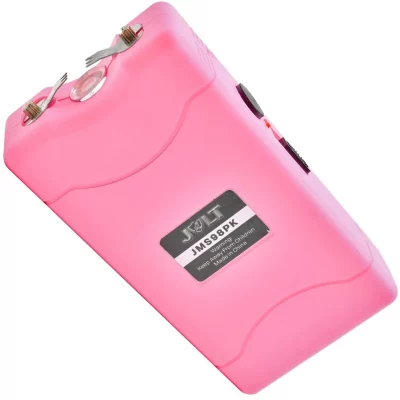
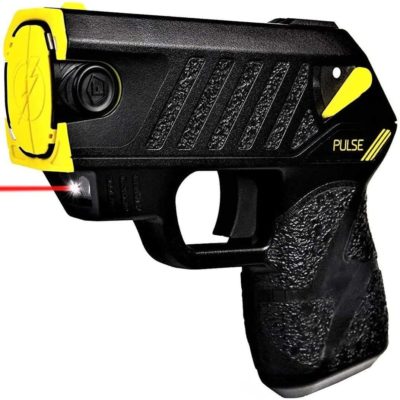
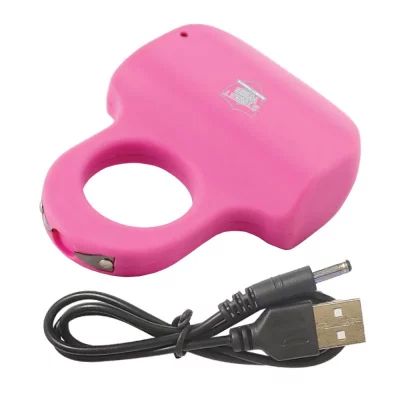

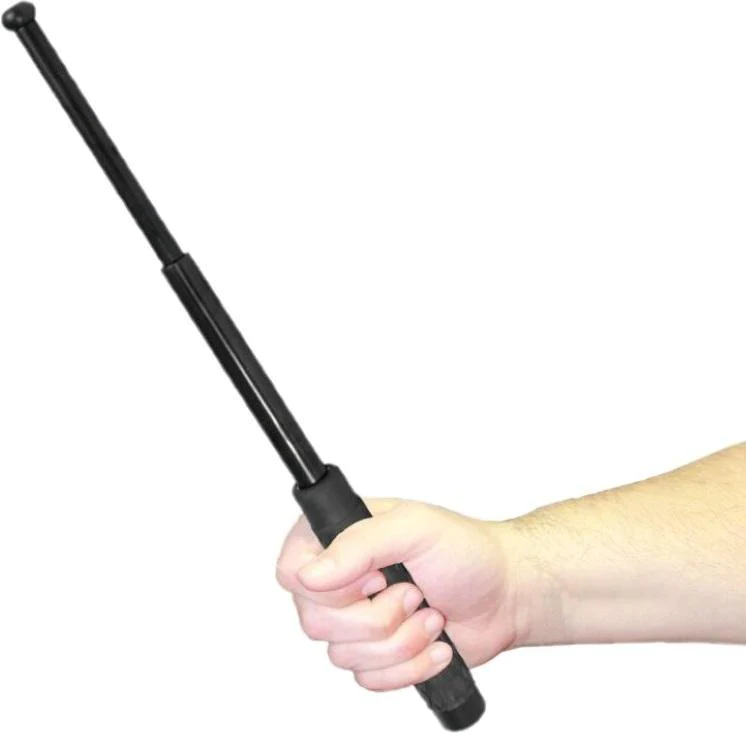
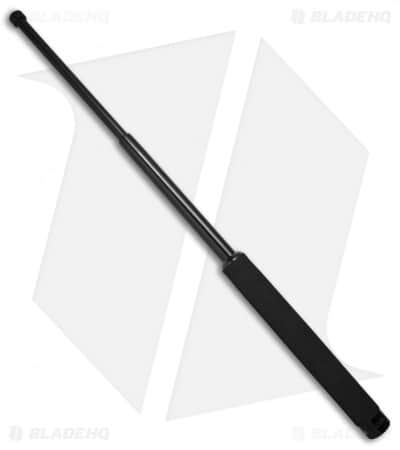


would be great if these weapons were legal in Australia but sadley even pepper spray is not allowed